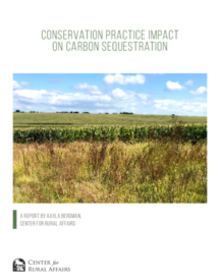Due to recent glaciation, the midwestern U.S. has some of the most productive soils in the world. These rich soils contain a layer of organic matter, called the O horizon, atop a layer of topsoil, called the A horizon. Both of these soil layers contain nutrients necessary for plant growth.
Agricultural land use is a significant driver of soil organic carbon levels. Over the past 150 years, agriculture has grown to be one of the leading industries for the midwestern region. Consequently, the A horizon has been completely removed from approximately one third of the Midwest.
Fertile soils in the region are susceptible to soil organic carbon loss due to land management practices, however a variety of management and structural practices allow farmers to produce crops while maintaining healthy soils and sequestering carbon.
Conservation on working lands provides many ecosystem services talked about frequently. Those include water quality and soil health improvement, wildlife habitat, and reduced operation cost. Not covered as often is the carbon sequestration and greenhouse gas emission reductions these practices provide. This report takes a closer look at this lesser-advertised benefit of many conservation practices used today.
Farm and Food
Policy


